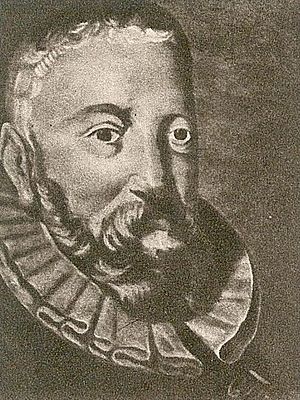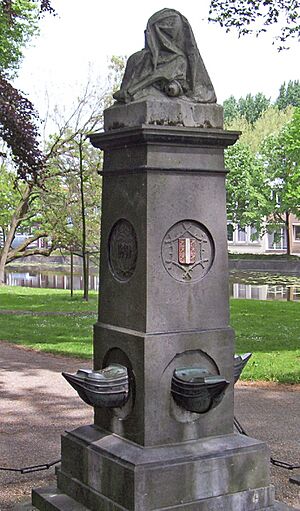Cornelis de Houtman facts for kids
Quick facts for kids
Cornelis de Houtman
|
|
|---|---|
 |
|
| Born | 2 April 1565 |
| Died | 1 September 1599 (aged 34) |
| Nationality | Dutch Republic |
| Occupation | Explorer |
| Employer | Compagnie van Verre |
| Relatives | Frederick de Houtman (brother) |
Cornelis de Houtman (born April 2, 1565 – died September 1, 1599) was a Dutch explorer. He was the brother of Frederick de Houtman. Cornelis found a new sea route from Europe to the East Indies. This journey helped start the Dutch spice trade. Before this, the Portuguese Empire controlled most of the spice trade. So, Houtman's trip was a big win for the Dutch. Even though the trip had many problems, it was a very important step. Houtman also worked as a spy. He gathered secret information about sea routes while in Portugal.
Contents
Cornelis de Houtman's First Voyage
In 1592, merchants from Amsterdam sent Cornelis de Houtman to Lisbon, Portugal. His mission was to learn as much as he could about the Spice Islands. At this time, Portugal and Spain were united. They had closed their ports to Dutch ships since 1585. This was because of the Eighty Years' War.
Gathering Information for the Journey
Houtman stayed in Portugal for about two years. He secretly gathered important information about the seas and lands in the East. He learned about coastlines, reefs, and sea currents. He also found out about winds, landmarks, and local people. This information was very helpful for future Dutch voyages. Around the same time, Jan Huygen van Linschoten returned from India. He also had valuable knowledge.
Starting the Expedition
The merchants decided that Bantam in Java was the best place to buy spices. In 1594, these merchants created a company called the Compagnie van Verre. On April 2, 1595, four ships left Amsterdam. Their names were the Mauritius, Amsterdam, Hollandia, and the Duifje.

Challenges During the Voyage
The journey faced many problems from the start. Many sailors got scurvy after only a few weeks. This was because they did not have enough fresh food. At Madagascar, seventy people died and were buried. This bay is now known as the Dutch cemetery. After one of the ship captains died, arguments started among the remaining captains and traders.
In June 1596, the ships finally reached Banten. This was a port in northwestern Java. Jan Huyghen van Linschoten had advised them to avoid the Strait of Malacca. This strait was controlled by the Portuguese. Instead, they sailed through the Sunda Strait.
Dealing with Local Rulers
De Houtman met the Sultan of Banten. The Sultan seemed happy to make a treaty with the Dutch. He wrote, "We are well content to have a permanent league of alliance and friendship with His Highness the Prince Maurice of Nassau, of the Netherlands and with you, gentlemen."
However, the local Portuguese traders became suspicious. De Houtman did not buy any black pepper. He wanted to wait for the next harvest. Sadly, De Houtman was not good at talking with people. He was rude to the Sultan. Because of his behavior, he was sent away without buying any spices.
The ships then sailed east to Madura. Pirates attacked them on the way. In Madura, the people welcomed them peacefully. But De Houtman ordered his men to attack the local people. This was his revenge for the earlier pirate attack.
Journey to Bali and Return
The ships then sailed to Bali. They met the island's king. On February 26, 1597, they managed to get some peppercorns. Two of the crew members decided to stay on the island. At Bawean, one of the ships, the Amsterdam, was set on fire on purpose. Its crew was divided among the other three ships.
The sailors were very tired of the long journey. They decided not to go to the Moluccas. Instead, they chose to return to Holland. That evening, another one of the skippers died. Some people accused De Houtman of poisoning him.
Portuguese ships stopped them from getting water and supplies at Saint Helena. Out of 249 men who started the trip, only 87 returned. They were too weak to even tie up their ships by themselves.
Cornelis de Houtman's Death
Even though the first trip was very difficult and many lives were lost, it was a symbolic victory. It showed that the Dutch could reach the East Indies. This journey is seen as the start of Dutch colonization in Indonesia. Within five years, 65 more Dutch ships sailed east to trade. Soon, the Dutch would take over much of the spice trade in the Indian Ocean.
On his second trip to the East in 1599, Cornelis de Houtman worked for a different company. He and his men arrived in Aceh. The Sultan of Aceh first accepted him peacefully. But De Houtman insulted the Sultan. He had already caused problems with the Banten Sultanate before arriving in Aceh. Feeling overconfident, he challenged the Sultan.
This led to his defeat by the Sultan's daughter, Admiral Keumalahayati. She led her Inong Balee Army against him. Because of this event, Queen Elizabeth I of England decided not to try to colonize directly. Instead, she sent a representative to the Sultan of Aceh. She asked for permission to enter the Strait of Malacca.
See also
 In Spanish: Cornelis de Houtman para niños
In Spanish: Cornelis de Houtman para niños

